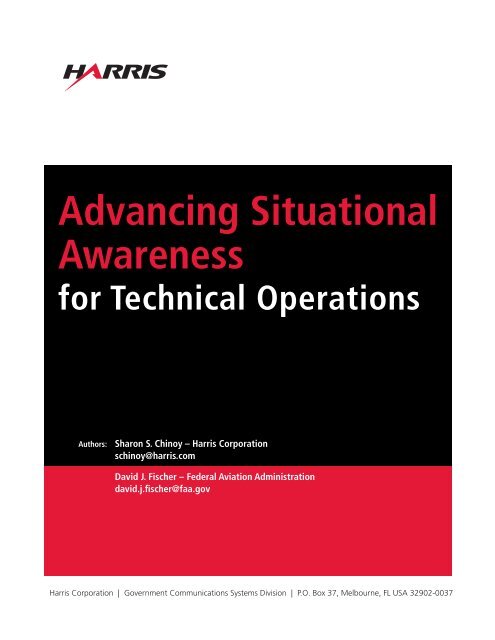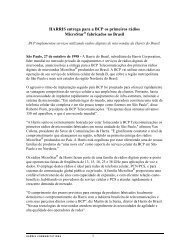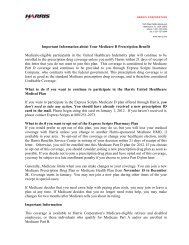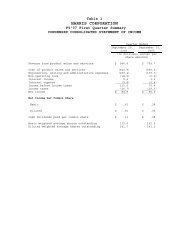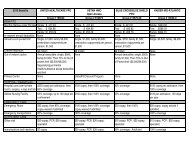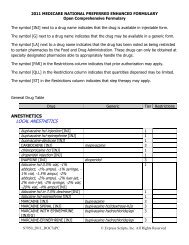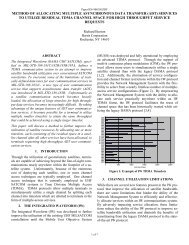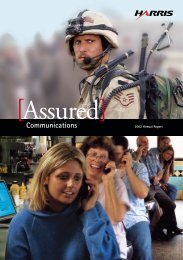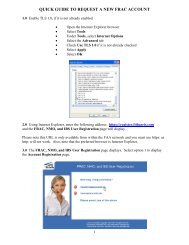Advancing Situational Awareness for Technical Operations
Advancing Situational Awareness for Technical Operations
Advancing Situational Awareness for Technical Operations
Create successful ePaper yourself
Turn your PDF publications into a flip-book with our unique Google optimized e-Paper software.
<strong>Advancing</strong> <strong>Situational</strong><br />
<strong>Awareness</strong><br />
<strong>for</strong> <strong>Technical</strong> <strong>Operations</strong><br />
Authors: Sharon S. Chinoy – Harris Corporation<br />
schinoy@harris.com<br />
David J. Fischer – Federal Aviation Administration<br />
david.j.fischer@faa.gov<br />
Harris Corporation | Government Communications Systems Division | P.O. Box 37, Melbourne, FL USA 32902-0037
ADVANCING SITUATIONAL AWARENESS<br />
FOR TECHNICAL OPERATIONS<br />
Harris Corporation, Government Communications Systems Division<br />
P.O. Box 37, Melbourne, FL USA 32902-0037<br />
Sharon S. Chinoy<br />
Harris Corporation, GCSD<br />
schinoy@harris.com<br />
David J. Fischer<br />
Federal Aviation Administration<br />
david.j.fischer@faa.gov<br />
__________________________________________________________________________________<br />
ABSTRACT<br />
Maintaining availability of system resources is critical<br />
to air transportation operations. The current National<br />
Airspace System (NAS) architecture is a<br />
large, complex System of Systems (SoS). As it<br />
evolves to the future enterprise architecture <strong>for</strong><br />
NextGen, tools <strong>for</strong> the FAA <strong>Technical</strong> <strong>Operations</strong><br />
organization must trans<strong>for</strong>m from individual program<br />
maintenance subsystems to a more consolidated<br />
net-centric approach.<br />
In partnership, Harris Corporation and the FAA program<br />
office <strong>for</strong> the FAA Telecommunications Infrastructure<br />
(FTI) program are defining and implementing<br />
user interfaces <strong>for</strong> improving situational<br />
awareness, considering various <strong>Technical</strong> <strong>Operations</strong><br />
mission needs. FTI provides a foundation <strong>for</strong><br />
this ef<strong>for</strong>t, as its telecommunication services support<br />
many NAS systems and it enables a net-centric<br />
approach <strong>for</strong> sharing content through the existing<br />
operational Network Management and <strong>Operations</strong><br />
(NMO) user interface and nationwide backbone<br />
network. The new capabilities being developed are<br />
referred to as the FTI <strong>Operations</strong> <strong>Situational</strong><br />
<strong>Awareness</strong> Monitor (FOSAM) tool. This paper<br />
presents a discussion of the overall need <strong>for</strong> improved<br />
maintenance tools and an overview of the<br />
FOSAM initiative.<br />
KEY WORDS<br />
Non-Export Controlled In<strong>for</strong>mation<br />
<strong>Technical</strong> <strong>Operations</strong>, <strong>Situational</strong> <strong>Awareness</strong>, NAS,<br />
NextGen, FTI<br />
INTRODUCTION<br />
The availability of NAS resources is critical to the<br />
safety and efficiency of air transportation, as well as<br />
support to military and homeland security operations.<br />
For example, in the 2010 fiscal year, there<br />
were 2,420 delays due to NAS resources (Federal<br />
Aviation Administration, 2010).<br />
The NAS architecture is comprised of thousands of<br />
systems serving Air Traffic Control (ATC) (Federal<br />
Aviation Administration, 1999), (Ahlstrom and<br />
Muldoon, 2004). Figure 1 illustrates a version of the<br />
“simplified NAS.” Some equipment is capable of<br />
Remote Maintenance Monitoring (RMM) (e.g., navigation<br />
aids, radars, Instrument Landing Systems<br />
(ILS), Ambient Lighting Systems (ALS)). These items<br />
send status to the FAA through the Maintenance<br />
Automation System Software (MASS) <strong>for</strong> display.<br />
Other systems and equipment elements evolved<br />
over several decades by various contractors, and<br />
provide unique interfaces and protocols <strong>for</strong> monitoring<br />
and control, generally in stand-alone applications.
The NAS is particularly complex due to redundant<br />
elements, diversity, backup systems, and<br />
an interrelationship of systems to serve one<br />
functional service or thread <strong>for</strong> ATC or mission<br />
support applications. As systems become Internet<br />
Protocol (IP) enabled, this interrelationship<br />
becomes more pronounced. In addition,<br />
the systems are geographically dispersed<br />
throughout the United States and internationally,<br />
and serve the FAA and other agencies.<br />
Often configurations are unique across installations.<br />
For these reasons, the ability to detect<br />
a fault is necessary, but not sufficient, <strong>for</strong> effectively<br />
managing the NAS.<br />
The <strong>Technical</strong> <strong>Operations</strong> (TO) organization is<br />
responsible <strong>for</strong> managing and maintaining the<br />
various systems. TO specialists need both<br />
technical expertise and geographical domain<br />
expertise (Truitt, 2002). The FAA TO organization<br />
includes the centralized National <strong>Operations</strong><br />
Control Center (NOCC), three regional<br />
<strong>Operations</strong> Control Centers (OCCs), Systems<br />
<strong>Operations</strong> Centers (SOCs) at Air Route Traffic<br />
Control Centers (ARTCCs) and large Ter-<br />
Figure 1. The simplified NAS<br />
Non-Export Controlled In<strong>for</strong>mation<br />
minal Radar Approach Control Centers (TRA-<br />
CONs), and additional facilities at the local and<br />
regional level. In addition, two National Enterprise<br />
Management Centers (NEMCs) support<br />
IP related systems. Each functional organization<br />
maintains systems within its area of responsibility.<br />
The TO organization must coordinate with<br />
ATC <strong>for</strong> all maintenance activities. ATC determines<br />
priority and criticality. TO also coordinates<br />
with contractors who per<strong>for</strong>m maintenance<br />
via service contracts (as is the case <strong>for</strong><br />
the FTI program, Flight Services 21 (FS21)<br />
program, or contract towers), local airport authorities,<br />
or with other agencies (e.g., the Air<br />
Force) <strong>for</strong> release and escort access. Coordination<br />
among stakeholders is influenced by<br />
current tasks, goals, and constraints.<br />
Shared situational awareness is essential <strong>for</strong><br />
effective decision-making and communications<br />
among stakeholders. What exactly is<br />
situational awareness? The most widely accepted<br />
definition is “the perception of ele-
ments in the environment within a volume of<br />
time and space, the comprehension of their<br />
meaning, and the projection of their status in<br />
the near future” (Endsley, 1995). The key<br />
words are perception, comprehension, and<br />
projection. Thus, having a system detect<br />
and report its status, such that an operator<br />
can perceive it, is only part of the equation<br />
<strong>for</strong> obtaining situational awareness.<br />
An individual’s mental model affects situational<br />
awareness. “Mental models are representations<br />
of reality that people use to understand<br />
specific phenomena” (Kearsley,<br />
2011). They are developed over time with<br />
experience.<br />
Other factors affecting situational awareness<br />
include goals and objectives, expectations,<br />
operator abilities, experience and training,<br />
system design (including user interface),<br />
complexity, amount of in<strong>for</strong>mation to track<br />
stress and workload (especially within a dynamic<br />
environment).<br />
<strong>Situational</strong> awareness is also extended<br />
beyond the individual to team situational<br />
awareness, which is “the degree to which<br />
every team member possesses the SA required<br />
<strong>for</strong> his or her responsibilities”<br />
(Endsley, 1995). Poor situational awareness<br />
by any team member may lead to errors or<br />
reduced per<strong>for</strong>mance in achieving team<br />
goals. Shared situational awareness occurs<br />
when team members have a common understanding<br />
of the situation, based on in<strong>for</strong>mation<br />
relevant to their specific sub-goals, in<br />
an ef<strong>for</strong>t toward achieving the overall team<br />
goal.<br />
Several studies have been per<strong>for</strong>med to assess<br />
factors that affect situational awareness<br />
and decision-making <strong>for</strong> <strong>Technical</strong> <strong>Operations</strong>,<br />
including the organizational transition from 42<br />
Maintenance Control Centers (MCCs) towards<br />
three OCCs (Truitt and Ahlstrom, 2000) and<br />
artificial intelligence applications <strong>for</strong> FAA maintenance,<br />
monitoring, and control operations<br />
(Adkisson, 1994). Some recommendations<br />
included:<br />
• Consolidating several monitoring systems<br />
into a fewer number in order to integrate<br />
in<strong>for</strong>mation and increase situational<br />
awareness<br />
• Providing a centralized alarm processing<br />
application<br />
Non-Export Controlled In<strong>for</strong>mation<br />
• Providing a framework <strong>for</strong> distributed<br />
maintenance<br />
• Providing maintenance documentation<br />
(e.g., technical instructions and schematics)<br />
in an electronic media<br />
• Creating a database <strong>for</strong> storing expert<br />
in<strong>for</strong>mation<br />
• Providing artificial intelligence or extensive<br />
training <strong>for</strong> predicting future events<br />
In another study, researchers investigated<br />
coordination between TO and ATC. Three<br />
major categories were identified <strong>for</strong> communication:<br />
coordination, in<strong>for</strong>mation dissemination,<br />
and logging (Ahlstrom, Muldoon, and<br />
Dorsey, 2009). TO specialists spend a significant<br />
amount of time coordinating with<br />
ATC. However, the TO and ATC organizations<br />
need different in<strong>for</strong>mation <strong>for</strong> handling<br />
their tasks. While TO needs more detailed<br />
in<strong>for</strong>mation about the equipment, ATC is<br />
generally more interested in the predicted<br />
time <strong>for</strong> the outage and its return to normal.<br />
Other factors that affect their decision <strong>for</strong><br />
release include the impact on operations,<br />
current and predicted traffic loads, runway<br />
configurations, system interdependencies<br />
(especially <strong>for</strong> radar feeds), and weather<br />
in<strong>for</strong>mation (Truitt and Ahlstrom, 2000). In<br />
an ef<strong>for</strong>t to reduce errors, reduce workload,<br />
and increase the efficiency of the NAS, the<br />
researchers’ recommendations included the<br />
following improvements:<br />
• A shared system <strong>for</strong> event status<br />
• Automatic in<strong>for</strong>mation transfer between<br />
systems<br />
• Automation in lieu of voice calls<br />
• Easy-to-use online lookup tools<br />
• In<strong>for</strong>mation tailored to user need<br />
In another study researchers evaluated the<br />
potential <strong>for</strong> errors in the OCC environment.<br />
Table 1 lists some of the concerns identified<br />
(Ahlstrom, et al., 1999).<br />
Adkisson (1994) identified three major<br />
phases <strong>for</strong> expert system development: requirements<br />
engineering, knowledge engineering<br />
(including knowledge acquisition,<br />
rapid prototyping, production system of a<br />
database and user interface, and system<br />
test), and knowledge maintenance.
THE FOSAM INITIATIVE<br />
The FTI program provides telecommunication<br />
services <strong>for</strong> the FAA. There are more<br />
than 22,000 FTI services connecting over<br />
4,000 facilities and 50,000 users. By looking<br />
at the “Simplified NAS” figure, one can see<br />
how pervasive FTI is in supporting the NAS.<br />
Maintenance <strong>for</strong> site equipment and carrier<br />
circuits is the responsibility of the service<br />
provider, Harris Corporation. However, corrective<br />
and preventive maintenance activities<br />
must be coordinated with the FAA.<br />
The Need <strong>for</strong> FOSAM<br />
Non-Export Controlled In<strong>for</strong>mation<br />
It is essential <strong>for</strong> the FAA to be aware of the<br />
status and situation of the NAS with regard<br />
to its owned and leased services and<br />
equipment. This is especially important<br />
when services and equipment are utilized<br />
across district and regional airspace boundaries.<br />
FOSAM was created to achieve this<br />
purpose. FOSAM moves the FAA in the direction<br />
of complete awareness of NAS operations<br />
by giving the end user a geographic<br />
and tabular view of FTI services <strong>for</strong> the nation,<br />
individual domains, and adjacent airspaces.
Table 1. Concerns that may lead to errors within the OCC environment<br />
Category Concerns That May Lead to Errors<br />
Communication and<br />
coordination<br />
Setting priorities among<br />
multiple tasks<br />
Breadth vs. depth of knowledge<br />
and experience<br />
In its current configuration, FOSAM allows<br />
the users to see FTI services at-a-glance<br />
and in real time. This is a major step in providing<br />
a complete situational view of the<br />
NAS.<br />
The FAA currently monitors its own sites<br />
and services on an individual case-by-case<br />
basis through MASS Remote Maintenance<br />
Monitoring (RMM). Although this process<br />
allows technicians to see the status of their<br />
own facilities, it does not allow them to see<br />
what is happening overall (i.e., the big picture).<br />
To get that level of understanding,<br />
multiple phone calls and ticket reviews often<br />
need to be per<strong>for</strong>med. This process is very<br />
time consuming. In many instances, the FAA<br />
has collocated services and facilities that<br />
support both ARTCC and TRACON operations.<br />
For example, if a radar service <strong>for</strong> an<br />
en route center fails and a TRACON using a<br />
collocated Terminal Communication frequency<br />
located within the same facility also<br />
fails, it is difficult <strong>for</strong> the <strong>Technical</strong> Opera-<br />
• Failure to acknowledge in<strong>for</strong>mation<br />
• Confusion as to whether messages were received<br />
• Critical in<strong>for</strong>mation might not be communicated<br />
• Misunderstandings among stakeholders, especially between<br />
AT and TO due to differences in terminology and context<br />
• Communication among stakeholders who are not collocated<br />
• Number of voice communications between stakeholders<br />
potentially reaching unmanageable proportions<br />
• Difficulty of correctly setting priorities among tasks competing<br />
<strong>for</strong> limited time and resources<br />
• Errors induced by specialists who do not have the breadth of<br />
experience to establish priorities or maximize resources<br />
• Specialists failing to understand the functional relationships<br />
of equipment when problem solving<br />
Current status in<strong>for</strong>mation • Not being aware of critical events<br />
• Need <strong>for</strong> shared situation and status<br />
Critical facility in<strong>for</strong>mation • Difficulty tracking role of a facility in providing a level of service<br />
under different operating conditions leading to taking a<br />
resource out of service when needed<br />
Event ticketing • Tickets not opened, kept up to date, or closed in a timely<br />
manner, leading to errors<br />
• Workload <strong>for</strong> handling tickets<br />
Database errors • Incomplete, out-of-date personnel and resource in<strong>for</strong>mation<br />
in the database<br />
Non-Export Controlled In<strong>for</strong>mation<br />
tions Control Center (TOCC) to see the correlation.<br />
This is because one service is being<br />
monitored in the en route air traffic domain<br />
and the other in the terminal air traffic<br />
domain. Knowing that both types of service<br />
are down can help to determine probable<br />
cause and decrease the amount of time the<br />
services are unavailable. With FOSAM the<br />
FAA will see all sites (and services located<br />
at those sites) to assist in determining the<br />
expected full impact to ATC.<br />
The Harris Network <strong>Operations</strong> Control Center<br />
(NOCC) prepares, stores, and sends<br />
Maintenance Requests (MRs) to the applicable<br />
FAA TOCCs. A single MR may affect<br />
multiple FTI services. The MR must be approved<br />
by the FAA. As part of the approval<br />
process, the FAA TOCC coordinates with<br />
ATC. This approval process is challenging<br />
because it is difficult to understand the impact<br />
of the resulting service state (either<br />
outage or no loss of service due to redundant<br />
FTI elements) in relation to other non-
FTI planned or unscheduled maintenance<br />
activities and due to the complex interrelationship<br />
of NAS systems and elements.<br />
In addition, Immediate Service Release<br />
(ISR) notifications must be sent to the<br />
TOCCs <strong>for</strong> release approval prior to commencement<br />
of any maintenance or testing of<br />
FTI services. An ISR is requested by Harris<br />
to the FAA when a service is deemed to be<br />
in a full outage or a reduced service state.<br />
For a major telco outage or scheduled maintenance<br />
activity (ISR or MR), it is possible<br />
(and common) to have more than 200 service<br />
paths affected simultaneously. Prior to<br />
any maintenance being per<strong>for</strong>med, the responsible<br />
TOCC must grant approval to release<br />
services from ATC operations to the<br />
Tech Ops and telco technicians. On the surface<br />
it appears that an outage of this magnitude<br />
would cause a large impact on the NAS<br />
and ATC’s ability to control aircraft. However,<br />
with contingencies and existing backup<br />
services, a vast majority of these outages<br />
have no impact on air traffic control and the<br />
flying public. In contrast to ATC, the impact<br />
is quite the opposite <strong>for</strong> <strong>Technical</strong> <strong>Operations</strong><br />
who per<strong>for</strong>m monitoring, ticketing, and<br />
maintenance. In these cases <strong>Technical</strong> <strong>Operations</strong><br />
must evaluate each item in the MR<br />
or ISR to determine if anything will be unusable<br />
to ATC. With multiple TOCCs involved<br />
in these events, this impact determination<br />
becomes increasingly difficult. Approval <strong>for</strong><br />
release of services to begin work may take<br />
hours to complete. Not only does this delay<br />
service restorations, it also prevents FAA<br />
personnel from completing other required<br />
responsibilities in a timely manner. FAA<br />
technicians must sort through the MR or ISR<br />
to comprehend, project, and explain to ATC<br />
what will be unavailable <strong>for</strong> use and what<br />
actions or procedures, if necessary, ATC will<br />
have to implement to continue seamless<br />
operations. This process improved greatly<br />
with the introduction of the Telecommunications<br />
<strong>Operations</strong> Management Tool (TOMT)<br />
Impact Generator. The TOMT Impact Generator<br />
advises which services will be down or<br />
in a reduced mode, and more importantly,<br />
what services will still be available in support<br />
of the NAS. FOSAM incorporates this impact<br />
generation into a visual image <strong>for</strong> very quick<br />
assessment of the situation which eases a<br />
technician’s workload. Most importantly,<br />
evaluation of the maintenance activity to<br />
Non-Export Controlled In<strong>for</strong>mation<br />
gain release of services to begin maintenance<br />
is reduced from hours to minutes.<br />
The concept <strong>for</strong> a tool that gives a user a<br />
complete picture of what is happening in the<br />
NAS is not a new idea; however, the difficulty<br />
involved with showing multiple real-time<br />
outages on a geographical level without the<br />
need to manually update and maintain that<br />
tool has not been available until now. Previous<br />
attempts have required manual intervention<br />
to update in<strong>for</strong>mation. Data was difficult<br />
to interpret as the in<strong>for</strong>mation being<br />
presented was usually in line item <strong>for</strong>mat<br />
and required the user to decipher the impact<br />
of outages and events. There was also the<br />
problem of outdated or misleading in<strong>for</strong>mation<br />
being presented. In instances of a major<br />
catastrophe (e.g., hurricane, <strong>for</strong>est fire, etc.)<br />
the requirement to manually update a tool in<br />
real time was nothing short of overwhelming.<br />
Multiple reports of services failing or restoring<br />
would flood in. In these cases ticketed<br />
outages <strong>for</strong> sites and services (that should<br />
have been displayed in a situational awareness<br />
tool), many times went unnoticed until<br />
many hours later when the restorations occurred,<br />
thereby only providing part of the<br />
total picture.<br />
The FOSAM Design<br />
Conceptualization and development of FO-<br />
SAM began in the summer of 2010. The tool<br />
was to provide a pictorial view of the NAS<br />
and the telecommunication services that<br />
keep it running.<br />
The FAA and Harris <strong>for</strong>med a team of a systems<br />
engineer, software engineers and Subject<br />
Matter Experts (SMEs) to bring the concept<br />
of an automated situational awareness<br />
tool to reality. Each team member brought a<br />
skill set essential <strong>for</strong> the conceptual and detailed<br />
baseline implementation.<br />
Together the team used an agile development<br />
process to identify requirements, work<br />
out design solutions, and implement rules<br />
and relationships between services, sites<br />
and domains. Once approaches were implemented,<br />
they were reassessed <strong>for</strong> appropriateness<br />
in accomplishing the intended<br />
objective and modified as necessary. Although<br />
software technologies enabled the<br />
result, it was agreed by the stakeholders<br />
that the critical element to success was getting<br />
the right context in relation to the NAS,
FAA operations, and in FAA vernacular, integrated<br />
in a holistic manner, yet tailored to<br />
various user domains.<br />
One of the initial challenges the team faced<br />
was to determine if any tools currently in<br />
place could be used <strong>for</strong> FOSAM. This tool<br />
would need to be expandable, easily<br />
changed and accessible to the FAA, FAA<br />
contract support, and Harris employees alike.<br />
FTI already provided a Network Management<br />
and <strong>Operations</strong> (NMO) User Interface<br />
(UI) <strong>for</strong> the FAA to view status of FTI services.<br />
However, its original design was constrained<br />
by technologies available <strong>for</strong> early<br />
web-based applications which limited the<br />
approach to lists of data (e.g., event messages<br />
or status). As discussed previously,<br />
the FAA found they needed an at-a-glance,<br />
real-time updated graphical user interface<br />
that is now achievable with current state-ofthe-art<br />
software technology. It was agreed to<br />
build the FOSAM capabilities upon the existing<br />
NMO UI. The NMO UI already contained<br />
status reporting mechanisms <strong>for</strong> FTI services,<br />
trouble ticket views, and other data content<br />
relevant to FTI services and the sites<br />
that they support. It was also already available<br />
to authorized FAA users across the nation<br />
through a secure Virtual Private Network<br />
(VPN) over the FTI backbone network.<br />
Furthermore, since it is a web-based tool,<br />
new features could be implemented remotely<br />
without impact to ongoing operations.<br />
Several of the features desired <strong>for</strong> FOSAM<br />
are consistent with the research findings<br />
previously discussed. Original features of<br />
FOSAM were to:<br />
• Provide views based on needs of user<br />
types (e.g., NOCC, OCC, SOC)<br />
• Provide a geographic view of NAS status<br />
that could utilize web-based Geographic<br />
In<strong>for</strong>mation System (GIS) software<br />
technologies to show location<br />
• Provide status at a national level <strong>for</strong><br />
sites determined to be important; this<br />
evolved to major sites, OPSNET sites,<br />
and other sites of interest<br />
Non-Export Controlled In<strong>for</strong>mation<br />
• Provide a means to view status <strong>for</strong> other<br />
sites that could be shown or removed<br />
from display (through layers) as desired<br />
by the user<br />
• Provide “tabular” views based on site or<br />
service<br />
• Determine color-coding <strong>for</strong> status and<br />
rules <strong>for</strong> propagation through the hierarchy<br />
of displays<br />
• Provide views of service categories<br />
(e.g., to view all satellite services across<br />
the NAS)<br />
• Show radar coverage especially in light<br />
of an outage<br />
• Show AT sector impact due to FTI resources<br />
that caused outages or loss of<br />
redundancy <strong>for</strong> a frequency<br />
• Show relationships of redundant elements<br />
in service detail views<br />
• Import FAA Line Frequency (LF) data to<br />
provide the correlation of FTI services to<br />
air traffic services<br />
• Provide “product” views to show interrelationships<br />
of telecommunication services<br />
and other equipment that provide a<br />
service to Air Traffic Control<br />
• Provide a method to show predictive<br />
system impacts due to MRs or show impacts<br />
from ISRs<br />
• Integrate net-centric available in<strong>for</strong>mation<br />
into FOSAM as needed <strong>for</strong> maintenance<br />
operations (e.g., weather, flight<br />
objects)<br />
• Provide links to other existing NMO in<strong>for</strong>mation<br />
such as trouble tickets<br />
Figures 2 and 3 show examples of FOSAM<br />
screens.<br />
Designing a situation awareness tool is challenging<br />
<strong>for</strong> the NAS environment <strong>for</strong> several<br />
reasons. First, representing the NAS in<br />
product views is challenging because NAS<br />
equipment and telecommunication circuits<br />
that comprise the threads can be very complex<br />
to understand and to present in a sufficient,<br />
yet simple, manner (especially if they<br />
cross domain expertise).
Figure 2. Geographic View<br />
Figure 3. Service Visualization View<br />
Next, there are several stakeholders to accommodate<br />
with one tool. The users are<br />
responsible <strong>for</strong> different resources and may<br />
operate differently across facilities. A goal of<br />
FOSAM is to design views in multiple ways<br />
to accommodate their needs, preferences,<br />
and mental models, and then in<strong>for</strong>mally test<br />
with the applicable SMEs to validate the approach.<br />
Another challenge is how to manage and<br />
represent the facility locations. Although<br />
“FSEP” is the official source of facility data,<br />
the FTI program discovered that the data<br />
was insufficient <strong>for</strong> our program needs (e.g.,<br />
having 911 emergency-response validated<br />
addresses or accurate latitude/longitude<br />
coordinates, which are necessary <strong>for</strong> GISbased<br />
applications). The FAA and Harris<br />
defined a process to manage the transmittal<br />
and update of the facility data through an<br />
FAA contractor. Considerable ef<strong>for</strong>t was<br />
spent on achieving accuracy and consistency<br />
of data between the databases. Another<br />
discovery during the FTI implementation<br />
was that the FAA changes the names of its<br />
facilities, either because they simply desire<br />
to change the name (e.g., the FAA <strong>Technical</strong><br />
Center (FAATC) became the William J.<br />
Non-Export Controlled In<strong>for</strong>mation<br />
Hughes <strong>Technical</strong> Center (WJHTC)) or because<br />
new facilities are built to replace old<br />
facilities. In this case both facilities may exist<br />
until cutover is complete and the old facility<br />
then becomes inactive (or is demolished). At<br />
that time, the FAA changes the new facility<br />
name to the old facility name (but with the<br />
new location). In other cases a facility is<br />
moved from one address to another (e.g.,<br />
such as <strong>for</strong> leased facilities). Maintaining<br />
accuracy of the facility data and timing of<br />
updates between multiple FAA and Harris<br />
databases is a challenge that is shared<br />
beyond FTI, especially when so many artifacts<br />
use the facility codes in their products<br />
(e.g., drawings, documents, screens) which<br />
may not be modified through a simple database<br />
update.<br />
In addition to the facility data, the LF data<br />
posed issues. The content of the LF database<br />
is not consistent in <strong>for</strong>mat or in the way<br />
data was entered. This makes it difficult to<br />
use the content in a reliable manner <strong>for</strong><br />
presentation or as a decision-making aid.<br />
There is no single owner of the content,<br />
making it hard to clean up or en<strong>for</strong>ce data<br />
integrity. The LF data and the facility data<br />
issues exemplify the need <strong>for</strong> data sources<br />
to have a single authoritative source with a<br />
defined process <strong>for</strong> updates and distribution.<br />
This will also be important <strong>for</strong> NextGen programs.<br />
Another challenge is defining rules <strong>for</strong> status<br />
propagation from lower level status views to<br />
a nationwide status view. It is necessary to<br />
find the right balance <strong>for</strong> users to be notified<br />
of changes, without propagating insignificant<br />
events to the national level.<br />
Beta Testing<br />
In spring 2011, a Beta test group was<br />
<strong>for</strong>med to extensively evaluate FOSAM. The<br />
general intent of any Beta group test is to<br />
discover bugs, flaws, and weaknesses in a<br />
new program. In addition to these requirements<br />
the test group <strong>for</strong> FOSAM was asked<br />
to provide input to enhance the tool, to make<br />
it their own. During the initial training sessions<br />
the team was asked to evaluate how<br />
they do their current job and what FOSAM<br />
can do to make that job more efficient. The<br />
group was encouraged to show FOSAM to<br />
coworkers and discuss tool attributes <strong>for</strong><br />
potential growth.
The Beta group consisted of 30 members<br />
across the United States, including individuals<br />
from the FAA, Harris, and FAA contract<br />
support employees. Within this group were<br />
SMEs on FAA and telco service, software<br />
and system engineering, management, and<br />
program support. FAA employees were selected<br />
from FAA headquarters, ARTCCs and<br />
General National Airspace System (GNAS),<br />
and FAA district office environments.<br />
Beta testing was conducted <strong>for</strong> five weeks.<br />
The Beta SMEs documented their comments<br />
and submitted them on a weekly basis<br />
to the development team.<br />
With each week, trends <strong>for</strong> ideas in usage<br />
and features came into clearer focus. Consistent<br />
with Beta test periods as the test<br />
went deeper into the five-week period, the<br />
number of bugs and anomalies reported<br />
became fewer. The results the development<br />
team received from the Beta test group were<br />
surprising and somewhat overwhelming.<br />
Although the development team had built a<br />
tool that can monitor all FTI services, predict<br />
outage impacts, and display circuit in<strong>for</strong>mation<br />
at the click of a mouse, the Beta team<br />
clearly saw the additional potential of this<br />
valuable asset. The Beta team offered over<br />
200 suggestions <strong>for</strong> enhancements and features<br />
that the development team evaluated<br />
<strong>for</strong> possible implementation. Some suggestions<br />
(e.g., incorporating FAA tools into the<br />
FOSAM and user preferences) had already<br />
been discussed and planned. However,<br />
those suggestions solidified the development<br />
team’s belief that the FAA <strong>Technical</strong><br />
<strong>Operations</strong> world was ready <strong>for</strong> the next<br />
phase in maintenance and monitoring operations<br />
<strong>for</strong> NAS services and facilities. At<br />
the conclusion of the Beta test period the<br />
testers were provided a summary of the test<br />
results and encouraged to continue to share<br />
FOSAM with coworkers and colleagues.<br />
They were also asked to provide continued<br />
input on how FOSAM can improve the way<br />
the FAA conducts the business of situational<br />
awareness.<br />
Future Activities<br />
Based on results of Beta testing and discussions<br />
with other stakeholders, we determined<br />
that we are on the right track <strong>for</strong> providing a<br />
useful tool <strong>for</strong> the <strong>Technical</strong> <strong>Operations</strong> personnel.<br />
Future activities will consider:<br />
Non-Export Controlled In<strong>for</strong>mation<br />
• General usability features (e.g., adding<br />
hyperlinks, consistency of options across<br />
screens, color contrast)<br />
• Modifying content as needed <strong>for</strong> screens<br />
or pop-up boxes<br />
• Showing additional sites<br />
• Fine-tuning the rules <strong>for</strong> status propagation<br />
• Providing a means to ensure views that<br />
cannot be displayed all in one view (i.e.,<br />
requires scrolling) have the anomaly<br />
condition in view when first displayed<br />
• Search capabilities<br />
• Displaying bandwidth utilization<br />
• Determining if the product views can be<br />
data driven (versus manually drawn), so<br />
that changes can be automatically updated<br />
as the NAS changes<br />
• Defining a long-term method <strong>for</strong> periodic<br />
updates to the LF and sector data<br />
• Using the LF data <strong>for</strong> criteria in display<br />
approaches (not simply just a display of<br />
content)<br />
• Integrating other external FAA data content<br />
such as RMLS ticket in<strong>for</strong>mation<br />
and MASS critical event status<br />
• ATC0/ATC alert warnings<br />
• Receiving other data content related to<br />
emergency situations (e.g., fires, hurricanes,<br />
floods, power issues)<br />
• Storing user preferences<br />
• Providing a “Wiki” capability to enable<br />
users to store SME data.<br />
CONCLUSIONS<br />
Based on past research and our operational<br />
experiences, there is a great need to provide<br />
net-centric, real-time integrated NAS in<strong>for</strong>mation<br />
to improve <strong>Technical</strong> <strong>Operations</strong> situational<br />
awareness, decision-making, and<br />
workload.<br />
FOSAM will continue to be evolved to<br />
achieve near-term goals. As NextGen trans<strong>for</strong>mation<br />
occurs, integration with other FAA<br />
tools and databases will be considered <strong>for</strong><br />
extending FOSAM as a further enterprise<br />
solution.
ACKNOWLEDGEMENTS<br />
The authors wish to express their appreciation<br />
to the team members: Jeff McCoy, Joe<br />
Klapatch, John Worthy, Joe Kern, Adam<br />
Kushner, and Etan Shaul.<br />
ABOUT THE AUTHORS<br />
Sharon Chinoy is a Systems Engineer and a<br />
Certified Human Factors Engineering Professional<br />
(CHFEP). Most of her 25 years of<br />
experience focused on programs and pursuits<br />
<strong>for</strong> the FAA and other aviation related<br />
customers. Sharon has a master of science<br />
degree in engineering psychology from Florida<br />
Institute of Technology and a bachelor of<br />
science degree in interdisciplinary studies<br />
with a concentration in psychology, computer<br />
science, and business administration from<br />
the University of Florida. She is currently<br />
pursuing a Ph.D. in Human-Centered Design<br />
at Florida Institute of Technology.<br />
Non-Export Controlled In<strong>for</strong>mation<br />
David Fischer has been in service <strong>for</strong> over<br />
15 years with the U.S. Air Force and the<br />
FAA. He has a background in radar and automation<br />
through the USAF. David has been<br />
an FAA liaison assigned to oversee the FTI<br />
contract maintained by Harris Corporation<br />
<strong>for</strong> the past two years. He has recently been<br />
assigned the duties of <strong>Technical</strong> Support <strong>for</strong><br />
Department of Defense FTI communications<br />
services in addition to his current responsibilities.<br />
He has extensive field technician<br />
and <strong>Operations</strong> Control Center experience<br />
with the FAA.
REFERENCES<br />
Adkisson, L. (1994). Identification of Artificial<br />
Intelligence (AI) Applications <strong>for</strong> Maintenance,<br />
Monitoring, and Control of Airway Facilities.<br />
Federal Aviation Administration, William J.<br />
Hughes <strong>Technical</strong> Center. Atlantic City<br />
International Airport: Department of Transportation.<br />
Ahlstrom, V., and Muldoon, R. (2004). Visual<br />
Coding of Status <strong>for</strong> <strong>Technical</strong> <strong>Operations</strong><br />
Systems. Federal Aviation Administration,<br />
William J. Hughes <strong>Technical</strong> Center. Atlantic<br />
City International Airport: Department of<br />
Transportation.<br />
Ahlstrom, V., MacMillan, J., Tenney, Y.J.,<br />
Pew, R.W., Cranston, R.L., and Mog<strong>for</strong>d, R.<br />
(1999). Human Error Mitigation in Future<br />
<strong>Operations</strong> Control Centers. Federal Aviation<br />
Administration, William J. Hughes <strong>Technical</strong><br />
Center. Atlantic City International Airport: U.S.<br />
Department of Transportation.<br />
Ahlstrom, V., Muldoon, R., and Dorsey, H.<br />
(2009). Factors Affecting the Communication<br />
of Status In<strong>for</strong>mation Between <strong>Technical</strong><br />
<strong>Operations</strong> and Air Traffic Personnel. Federal<br />
Aviation Administration, William J. Hughes<br />
<strong>Technical</strong> Center. Atlantic City International<br />
Airport: U.S. Department of Transportation.<br />
Non-Export Controlled In<strong>for</strong>mation<br />
Endsley, M.R. (1995). Toward a theory of<br />
situation awareness in dynamic systems.<br />
Human Factors , 37 (1), 32-64.<br />
Federal Aviation Administration. (2010,<br />
September). Delays Dashboard. Retrieved<br />
July 18, 2011, from Technet Charts:<br />
http://technetcharts.faa.gov/new_nasdcharts/D<br />
elays_dashboard.asp<br />
Federal Aviation Administration. (1999).<br />
National Airspace System Architecture<br />
(Version 4.0). Washington, DC: Department of<br />
Transportation, Federal Aviation Administration.<br />
Kearsley, G. (2011). Mental Models. Retrieved<br />
June 12, 2011, from The Theory Into Practice<br />
Database: http://tip.psychology.org/models.html<br />
Truitt, T. R. (2002). Human-in-the-Loop<br />
Simulation <strong>for</strong> Airway Facilities <strong>Operations</strong>.<br />
HCI-Aero 2002 (pp. 155–159). American<br />
Association <strong>for</strong> Artificial Intelligence.<br />
Truitt, T.R., and Ahlstrom, V. (2000). Situation<br />
<strong>Awareness</strong> in Airway Facilities: Replacement<br />
of Maintenance Control Centers with<br />
<strong>Operations</strong> Control Centers. Federal Aviation<br />
Administration, William J. Hughes <strong>Technical</strong><br />
Center. Atlantic City International Airport:<br />
Department of Transportation.


